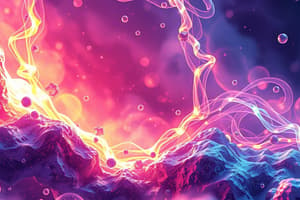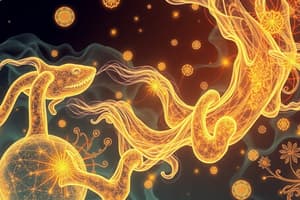Podcast
Questions and Answers
What does Le Chatelier's Principle state regarding changes in equilibrium?
What does Le Chatelier's Principle state regarding changes in equilibrium?
- Equilibrium can be established in any concentration of reactants.
- The system will remain unaffected by external disturbances.
- The equilibrium constant remains unchanged under all conditions.
- The system will shift to minimize the effects of disturbances. (correct)
Which of the following factors does NOT influence the rate of a chemical reaction according to kinetics?
Which of the following factors does NOT influence the rate of a chemical reaction according to kinetics?
- Concentration of reactants
- Presence of a solvent (correct)
- Surface area of reactants
- Temperature
According to the laws of thermodynamics, which statement is incorrect?
According to the laws of thermodynamics, which statement is incorrect?
- As temperature approaches absolute zero, entropy approaches a constant minimum.
- Energy cannot be created or destroyed.
- Entropy in an isolated system always increases.
- Energy can be created if sufficient force is supplied. (correct)
What characterizes a colloid in comparison to a solution?
What characterizes a colloid in comparison to a solution?
Which aspect of quantum chemistry does NOT pertain to the behavior of electrons?
Which aspect of quantum chemistry does NOT pertain to the behavior of electrons?
Which of the following statements regarding chemical thermodynamics is true?
Which of the following statements regarding chemical thermodynamics is true?
What is the primary principle of electrochemistry?
What is the primary principle of electrochemistry?
Which phase transition is characterized by the process of a solid turning directly into gas?
Which phase transition is characterized by the process of a solid turning directly into gas?
What does the study of spectroscopy primarily involve?
What does the study of spectroscopy primarily involve?
Flashcards are hidden until you start studying
Study Notes
Physical Chemistry
-
Definition: Branch of chemistry that deals with the physical properties and changes of chemical substances and the energy changes associated with these processes.
-
Key Concepts:
- Thermodynamics:
- Study of energy, heat, and work in chemical systems.
- Laws of thermodynamics:
- Energy cannot be created or destroyed (conservation of energy).
- Entropy of an isolated system always increases.
- As temperature approaches absolute zero, entropy approaches a constant minimum.
- Kinetics:
- Study of reaction rates and the factors affecting them.
- Factors influencing reaction rates:
- Concentration of reactants
- Temperature
- Presence of catalysts
- Surface area of reactants
- Equilibrium:
- State where the rates of the forward and reverse reactions are equal.
- Dynamic process with constant concentrations of reactants and products.
- Le Chatelier's Principle: If a system at equilibrium is disturbed, it will shift to counteract the disturbance.
- Thermodynamics:
-
States of Matter:
- Solids, liquids, gases, and plasmas, characterized by distinct properties (e.g., shape, volume).
- Phase transitions: Melting, freezing, condensation, evaporation, sublimation, and deposition.
-
Colloids and Solutions:
- Colloids: Mixtures where tiny particles are dispersed throughout a medium (e.g., fog, milk).
- Solutions: Homogeneous mixtures composed of solute (substance being dissolved) and solvent (substance doing the dissolving).
-
Quantum Chemistry:
- Application of quantum mechanics to chemical systems.
- Explains the behavior of electrons in atoms and molecules.
- Concepts include wave-particle duality, electron orbitals, and quantization of energy levels.
-
Spectroscopy:
- Study of the interaction between matter and electromagnetic radiation.
- Techniques include UV-Vis, IR, NMR, and mass spectrometry for analyzing substances.
-
Chemical Thermodynamics:
- Focus on the relationships between heat, work, and chemical reactions.
- Concepts include Gibbs free energy, enthalpy, and entropy.
-
Electrochemistry:
- Study of chemical processes that cause electrons to move, resulting in energy transfer.
- Applications include batteries, fuel cells, and electrolysis.
-
Applications:
- Understanding reaction mechanisms and energy profiles.
- Development of new materials and chemical processes.
- Environmental chemistry and studying the impacts of chemical processes on ecosystems.
Overview of Physical Chemistry
- Branch of chemistry focused on the physical properties and transformations of substances, alongside associated energy changes.
Thermodynamics
- Examines energy, heat, and work in chemical systems.
- Laws of thermodynamics:
- Conservation of energy: Energy cannot be created or destroyed.
- Second law: Entropy in an isolated system always increases.
- Third law: Entropy approaches a constant minimum as temperature nears absolute zero.
Kinetics
- Investigates reaction rates and factors that influence them.
- Influential factors include:
- Concentration of reactants
- Temperature
- Catalysts
- Reactants' surface area
Equilibrium
- Achieved when the rates of forward and reverse reactions are equal.
- Dynamic state with constant concentrations of reactants and products.
- Le Chatelier's Principle: A system at equilibrium will shift to counteract any imposed disturbances.
States of Matter
- Main states are solids, liquids, gases, and plasmas, each with unique characteristics (shape and volume).
- Phase transitions include:
- Melting, freezing, condensation, evaporation, sublimation, deposition.
Colloids and Solutions
- Colloids: Mixtures with finely dispersed particles (e.g., fog, milk).
- Solutions: Homogeneous mixtures consisting of solute (the dissolved substance) and solvent (the dissolving substance).
Quantum Chemistry
- Applies quantum mechanics to chemical systems, explaining electron behavior in atoms and molecules.
- Key concepts include:
- Wave-particle duality
- Electron orbitals
- Quantized energy levels
Spectroscopy
- The study of matter's interaction with electromagnetic radiation.
- Techniques for substance analysis include UV-Vis, IR, NMR, and mass spectrometry.
Chemical Thermodynamics
- Focus on the interplay between heat, work, and chemical reactions.
- Important concepts include Gibbs free energy, enthalpy, and entropy.
Electrochemistry
- Examines chemical processes resulting in electron movement and energy transfer.
- Applications encompass batteries, fuel cells, and electrolysis.
Applications of Physical Chemistry
- Enhances understanding of reaction mechanisms and energy profiles.
- Contributes to the development of new materials and chemical processes.
- Aids in environmental chemistry, studying the impact of chemical processes on ecosystems.
Studying That Suits You
Use AI to generate personalized quizzes and flashcards to suit your learning preferences.




